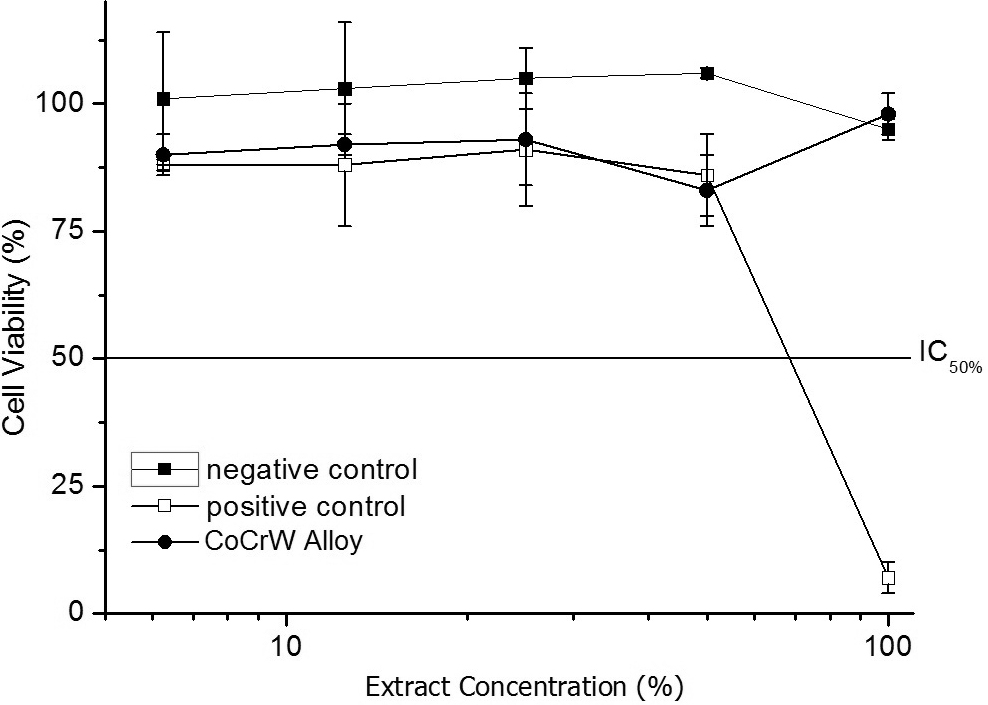Cytotoxicity Test
Cytotoxicity test was made and the results are in Figure 4; the cytotoxicity evaluation was performed by neutral red uptake assay. Positive and negative controls were used to confirm the adequate performance of the test procedure and/or to evaluate the results of CoCrW alloy, as well as to control the cell sensitivity, extraction efficiency and other test parameters. The sample that presents cell viability above the IC50( ) line is considered nontoxic and under the IC50( ) line it is toxic.
Discussion
Figure 1A shows that the Ecorr in saline solution is more positive, suggesting a better passive film formation when compared to artificial saliva medium. The CoCrW alloy (Fig. 1A) showed small values of current density (1 to 10 µA/ cm2) for a large analyzed potential range indicating good characteristics of the passive film formed in both media. The CoCrW alloy presents lower passivating current densities in NaCl medium, suggesting more passivating film for sodium chloride than in artificial saliva. The chronoamperometric curves (Figs. 1B and 1C) showed constant current density values even at high potentials, indicating the absence of pitting corrosion. The results have shown that CoCrW alloy presents only generalized corrosion at 0.9 V with high current density values in both media.
The characteristics of the passive film were investigated by EIS at Ecorr and 0.25 VSCE. The results are presented in Figures 2A and 2B. Bode phase diagrams are typical of passive systems with high values of both real and imaginary parts of the impedance at low frequencies. In the Bode diagrams the values of Z were about 105 Ω/cm² and the angle greater than 75º, showing the high resistive and capacitive characteristics of the formed film. Bode phase diagrams point out to the same mechanism in artificial saliva and sodium chloride. Figure 2C also shows the fitting of the experimental results according to simulated equivalent circuits. Good agreement between the experimental results and the equivalent circuits proposed is observed on the entire range of studied frequencies, suggesting qualitatively the same mechanism in both media. The film formed in sodium chloride medium (Fig. 2B) has better quality than that formed in artificial saliva (Fig. 2A).

Figure 4. CoCrW alloy viability curves in the cytotoxicity assay by the neutral red uptake methodology.
The composition of the passive film was analyzed by XPS at Ecorr. The amount of chromium and cobalt in the passive film formed in sodium chloride is greater than in artificial saliva. The protective film is formed by chromium oxide in both media (20). These results were also obtained by Hodgson et al. (21). In CoCr-based alloys, only at high potential will be found another state of chromium oxidation, such as Cr (VI) (21,22).. The chemical shift between Co2+ and Co3+ is very small (22-24), indicating a difficulty to characterize the oxidation state on the metallic surface. The low amount of cobalt in the film suggests that it diffuses into the solution and it does not significantly contribute
to the oxide phase.
In this study the tested alloy did not present toxic effects even at 100 extract concentration. All the viability curves are above the cytotoxicity index line, which means that the CoCrW alloy showed no cytotoxicity effects in this assay.
In this study the CoCrW alloy presented good behavior with the formation of a uniform passive film rich in chromium (III) oxide and a lower amount of cobalt oxides. The film formed in 0.15 mol.L-1 NaCl is more capacitive and resistive than the one formed in artificial saliva. The chemical complexity of the artificial saliva probably contributes to greater instability of the passive film. SEM and EDS show that the CoCrW alloy presents niobium carbide and silicon and manganese oxides as non-metallic inclusions. Cytotoxicity tests validated the non-cytotoxic
effect of the alloy according to the used methodology.
The results of this study suggest that CoCrW alloys from the electrochemical and cytotoxicity point of view may be used as biomaterials to be applied in prosthesis on dental implants.

